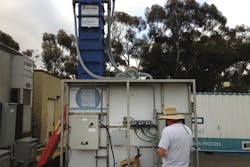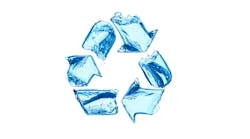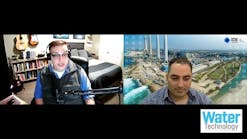Potable water supply professionals continue to struggle with rising populations, drought, shrinking groundwater and surface water sources. Early in the game, no solution to the sustainable water supply problem is out of the question. Fortunately, current technology has the ability to defuse the concerns often associated with hysterical media headlines such as "Toilet to Tap."
Worldwide, drinking water is typically sourced from groundwater or surface water supplies. In several states — including Texas, Arizona, New Mexico and California — both traditional sources are under immense stress mainly because of population growth and lengthy droughts. New sources of potable water are being sought to help generate sustainable water supplies. One new source is planned potable reuse, during which potable water supplies are supplemented with treated wastewater.
The traditional treatment approach for potable reuse has incorporated reverse osmosis (RO) membranes to achieve treatment goals. Although effective, RO-based treatment systems have high energy demands and produce brine reject streams that must be managed, either through disposal, further treatment or volume reduction. Advanced treatment processes that minimize or eliminate the need for RO are gaining popularity and have been validated on pilot and demonstration scale projects.
Two ozone-enhanced biofiltration projects
In California, two high-profile projects are paving the way for demonstrating the effectiveness of ozone-enhanced biofiltration as a key treatment process in potable reuse facilities. Pure Water San Diego (PWSD) is the city’s phased, multiyear program to use proven water purification technology to produce a safe and sustainable high-quality water supply for San Diego. The WateReuse Research Foundation (WRRF) commissioned a study in partnership with the Upper San Gabriel Valley Water District to evaluate different treatment trains incorporating ozone-enhanced biofiltration.
Currently, 80 percent of the San Diego region’s water supply is imported. Local supplies and conservation account for the remaining 20 percent of the total supply. The region’s reliance on imported water causes San Diego’s water supply to be impacted by shortages and susceptible to price increases. For example, in 2008, water supplied from the Bay-Delta was restricted to protect endangered fish species. In addition, drought conditions in Southern California have further impacted water supply availability. With the region’s population projected to reach 3.9 million by 2030, demands will only increase and place further strain on these limited water resources.
The PWSD program is a cost-effective investment for the city’s future water needs and will provide a reliable drinking water supply that is locally controlled and drought-proof. A water purification facility capable of producing up to 30 million gallons per day (mgd) of purified water is scheduled to be operational by 2021. The long-term goal — producing 83 mgd, one-third of San Diego’s future drinking water supply — is scheduled for 2035.
Xylem’s MiProTM Pilot Plant is fully containerized and offers the opportunity to test and select the best AOP based on project requirements.
In addition, the Upper San Gabriel Valley Municipal Water District (USGVMWD) is part of a team involved in the WRRF’s project 11-02, evaluating alternative treatment trains for potable reuse including the ozone-enhanced biologically active filtration. PWSD subsequently purchased demonstration units for long-term evaluations to prove this integrated treatment process can meet water quality goals, while also improving the operational efficiency of downstream treatment processes. The USGVMWD has already performed a pilot test of the system as part of the WRRF’s research project to demonstrate that treatment trains alternative to the traditional membrane approach can successfully treat recycled water to potable water standards.
Xylem’s Leopold Oxelia Ozone-Enhanced Biofiltration System combines the treatment synergy of ozone oxidation and biologically active filtration into a single process solution. Ozone oxidation breaks down recalcitrant organic carbon to make it biodegradable. Then naturally occurring microbes attach to a fixed bed filter and provide free aerobic biological treatment of the partially oxidized organic carbon for complete destruction of total organic carbon (TOC), trace contaminants and oxidation byproducts. A centralized control system optimizes the biofilter operation based on ozone dosage and effluent water quality, optimizing the backwash sequencing and biological activity in real time. The advanced process control creates the opportunity to minimize the energy consumption associated with ozone generation while maintaining target effluent water quality.
The PWSD project
The City of San Diego’s North City Water Reclamation Plant has a 1.5-mgd ozone/biological activated carbon (O3/BAC) system that is providing pretreatment to membrane filtration (MF), RO and ultraviolet advanced oxidation process (UV-AOP), which produces 1 mgd of product water.
The demo product water is then blended back in with the city’s non-potable recycled water for total dissolved solids reduction. Water is sampled for demonstration purposes and tasting is allowed by the public.
This treatment train — O3/BAC/MF/RO/UV-AOP — is currently being considered in a project that will deliver purified water to the Miramar Reservoir. A decision on whether it is in the city’s best interest to go to the Miramar Reservoir (which would require O3/BAC) or San Vicente Reservoir (which will not have O3/BAC) will occur in 2016. Considerations will include total economics, constructability, operational flexibility — both at the treatment plant and ability to store and move around other water supplies — as well as permitting and public acceptance.
Wedeco ozone and Leopold filtration are incorporated in Xylem’s integrated ozone/biofiltration pilot plant.
The USGVMWD project
The USGVMWD currently obtains its imported water supplies from the Metropolitan Water District of Southern California (MWD). MWD imports water from northern California through the California Aqueduct and from the Colorado River. To support groundwater production from the Main San Gabriel Basin, USGVMWD delivered imported water at an average rate of 32,000 acre-feet per year during the past two decades. Since these imported water supplies will be less reliable in the future, USGVMWD is pursuing alternative strategies to supplement its potable water portfolio with a renewable source.
Indirect potable reuse via groundwater recharge through surface-spreading basins has been identified as the most appropriate and promising option. Furthermore, USGVMWD would like to implement some form of advanced wastewater treatment to improve the quality of the tertiary effluent intended for spreading. Because of the significant costs of full advanced treatment, such as MF, RO, UV-AOP and hydrogen peroxide (UV/H2O2), USGVMWD is evaluating alternative treatment trains, including ozone and biological activated carbon (BAC), which can provide sufficient treatment for water reuse through surface spreading.
To support this evaluation, USGVMWD and Trussell Technologies collaborated on a proposal with funding from the Metropolitan Water District of Southern California Foundation Actions Funding (MWD FAF) Program. Trussell Technologies conducted a pilot study investigating TOC removal by a treatment train of ozone, BAC and soil aquifer treatment (SAT). The goal of this research was to minimize the TOC concentration in the product water while facilitating compliance with California’s groundwater recharge regulations that limit the wastewater effluent TOC concentration in groundwater to 0.5 milligram per liter (mg/L). The effects of variables such as biofilter media type (granular activated carbon versus anthracite coal), ozone to TOC (O3:TOC) ratio, biofilter empty-bed contact time (EBCT) and SAT hydraulic residence time (HRT) were studied to determine the optimal operating conditions for maximizing the TOC removal.
With an O3:TOC ratio of 1.0, a 39-minute EBCT in a BAC filter and a 56-day HRT for SAT, the secondary effluent TOC concentration was lowered from 6.3 mg/L to 1.4 mg/L, a reduction of 78 percent helped minimize the blend water required for compliance with California’s groundwater recharge TOC requirements. Impacts on other water quality parameters, such as N-nitrosodimethylamine, emerging contaminants and total coliform bacteria were also documented.
A separate pilot study conducted by Trussell Technologies with support from USGVMWD and a consortium of project partners as part of a WRRF study tested the efficacy of several treatment trains for the direct potable reuse of wastewater effluent. This study involved treatment trains with a variety of unit processes including ozone alone and ozone followed by BAC. This study demonstrated significant water quality and disinfection benefits enabling compliance with public health criteria for chemical and microbiological constituents. The primary role of ozone in these treatment trains was the disinfection of viruses, Cryptosporidium and bacteria, as well as the oxidation of emerging contaminants. An example of the water quality benefits of BAC was its removal of 60 percent to 95 percent of the N-nitrosodimethylamine in its feedwater.
The combination of ozone and BAC also provided significant operational benefits for downstream low-pressure membranes. For instance, the flux of an ultrafiltration membrane was more than doubled when operated with ozone and BAC pretreatment. Membrane cleaning and replacement frequencies also can be reduced since the ozone and BAC pretreatment removes organics that act as membrane foulants. Advantages like this could have a significant effect on the design and operation of a full-scale facility. Bromate formation control was an important factor in the MWD FAF and WRRF studies, and the testing that consisted of adding hydrogen peroxide before ozonation and the sequential addition of chlorine and ammonia before ozonation were both shown to be successful mitigation strategies.
Advantages
As demonstrated by these pilot studies, ozone and biofiltration have the potential to make significant contributions to potable reuse treatment and provide an alternative for utilities that want to minimize power consumption and secondary brine management requirements. These advantages create the opportunity for utilities that would normally find RO-based treatment trains prohibitive for implementing potable reuse to consider it.
Steve London is president of Steven London Associates, Apollo Beach, Florida. He has extensive background as a writer and editor specific to municipal water treatment technologies. For the past 20 years, the company has been involved in the development of application articles that highlight various solutions for water management professionals. London can be contacted at [email protected] or 813-645-0209.




